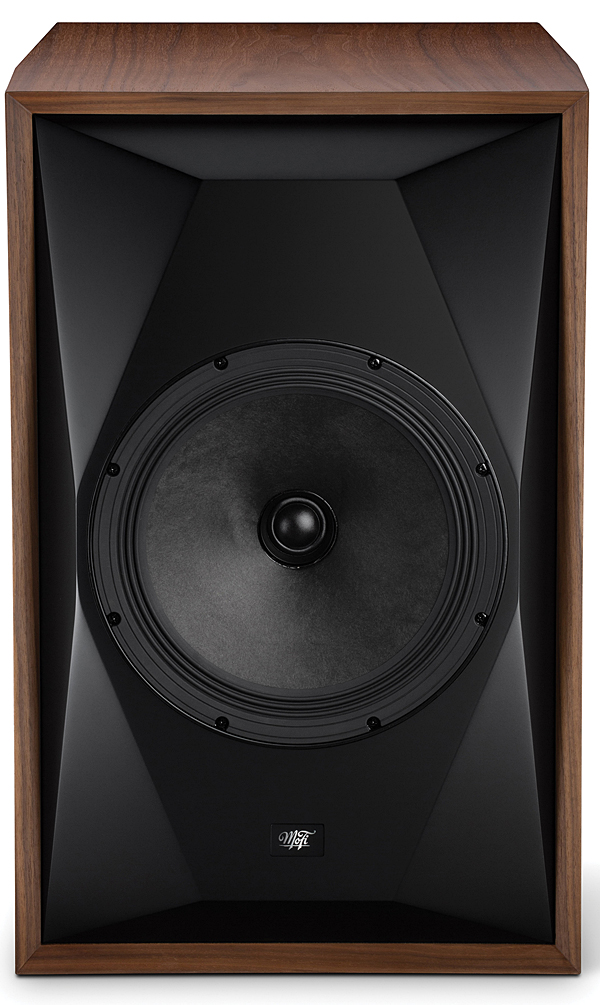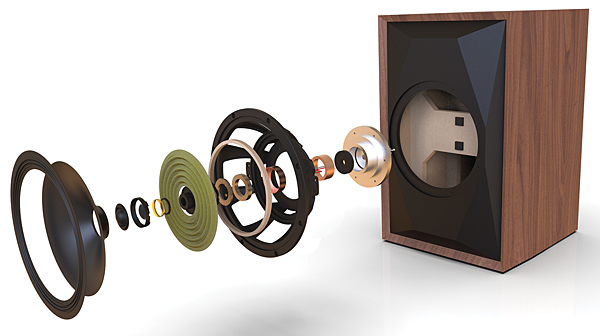Some background is in order. Using a large-diameter woofer endows a conventional two-way speaker with potentially high sensitivity and extended low frequencies. However, the large woofer's radiation pattern narrows at the top of its passband, whereas that of a tweeter mounted on a flat baffle is at its widest at the bottom of its passband. Even if the drive units' outputs are well-matched in the speaker's on-axis response, this discontinuity in the speaker's off-axis behavior results in an in-room balance that will sound bright. This is why favorably reviewed two-way designs tend to use a woofer with a 6.5" or even smaller diameter.
But ...
The SourcePoint 10 was designed by Andrew Jones, a well-respected veteran loudspeaker engineer with highly regarded models from KEF, Infinity, Pioneer, TAD, and ELAC in his resumé (footnote 1). Andrew, who is now celebrating two years with MoFi, has indeed done something different with his first design for the company.
The SourcePoint 10
The first thing you notice about this speaker is that the sculpted, 2"-thick front baffle has a single, centrally placed drive unit with a 1.25" soft-dome tweeter mounted concentrically at the center of the 10" woofer's paper-pulp cone. The second thing you notice is that instead of a conventional half-roll rubber surround for the cone, the woofer, which is reflex loaded with twin ports on the rear panel, uses an old-fashioned corrugated surround. The third thing you notice is that this is a large, heavy design for a standmount; it measures 22.5" × 14.5" × 16" with an internal volume of 50l—that's 13.2 gallons—and weighs just over 46lb.
Andrew Jones and MoFi's Jon Derda visited the day after I unboxed the SourcePoint 10s. As they prepared to set up the speakers in my room, I asked Andrew why he had settled on a two-way concentric design rather than a three-way and why, considering that, he had decided to use such a large woofer (footnote 2).

"Pretty much 100% of the designs I've done with concentric drivers have been three-way. And that's because with a concentric driver, you don't want the cone moving too far. The more movement you allow it to have, the more compromises you're getting, because you get amplitude modulation. ... You also need a bigger surround, [which] disrupts the wavefront from the tweeter, [and the] delayed reflection off the cone causes differences in the frequency response.
"The problem [with a three-way] is the complication, the extra cost, ... and trying to pick the frequency where you should cross over" from the woofer to the midrange. "Should it be as low as 80Hz? That would be very, very costly to do in terms of parts costs for a passive crossover. And how far down do I want to take that midrange, especially given its size and everything I need to do to control how well it works as a waveguide for the tweeter? So, could I do a two-way concentric? Because if I'm concerned about minimizing movement of the cone in a concentric, there's only two ways to do it. One is to restrict the frequency ranges, which is what you do when you turn it into a three-way. Or you make the woofer so big that most of the time it doesn't have to move hardly at all. Going from a typical 4.5" or 5" driver to a 10", I've got nearly four times the area and a quarter of the movement, which is significant.
"Because one of the briefs from MoFi was to have good, impactful, and extended bass. As well, as it's getting back into fashion to have big woofers, it would be fun to work with a big woofer. That could be cool, but I'd never done one before."
I asked how, in a two-way design with a 10" lower-frequency driver, which will start beaming at a relatively low frequency, does he match it to the wider dispersion of a tweeter?
"When you put the tweeter in a waveguide, it's not that it's narrowing the directivity everywhere. It's narrowing it at the lower frequencies, which is where you have the problem in matching the directivity to the woofer. So now you're going to narrow it progressively as you go down in frequency, correlating with how much sensitivity you gain due to the waveguide loading at the lower frequencies. With a good waveguide, you can reach about +10dB of on-axis output compared to no waveguide. And that's a huge advantage for working the tweeter because 10dB is a 10th of the power input you need in a critical range where there's still a lot of energy in the music. The waveguide ... reduces the energy input, the thermal compression, and the excursion requirement [of the tweeter].
"So if you can engineer a low resonant–frequency tweeter, you can run it down to a lower frequency"—it's 1.6kHz in the SourcePoint 10—"because it's running at a lower excursion compared to not having a waveguide, which more than makes up for the extra extension that you need to cross over the tweeter lower. And with a 10" waveguide, the improvement in efficiency or sensitivity and the reduction in excursion more than make up for the fact that you're crossing over at 1.6k. It enables you to get a very good, progressive, consistent off-axis performance.

"When the waveguide also needs to be a woofer or midrange cone, you've got to decide what is the best shape for it to act as a waveguide and what is the best shape for it to act as a cone, with controlled cone resonances. You hope that it's the same shape. So there's a choice of sizes and materials and everything else to optimize both the shapes simultaneously. So I started designing waveguides and getting them 3D-printed to see, what were the directivity characteristics? I came up with a shape that seemed to work very well. So the next thing was, okay, so now I have a cone that's going to work and need a surround. I knew I couldn't have a half-roll surround because that would disrupt the [tweeter's] wavefront. So it's got to be one of these corrugated surrounds like they use on pro speakers."
I asked Andrew why he had chosen a paper cone for the woofer. Wouldn't a 10" paper cone break up at a low frequency?
"About 3kHz. It's very smooth up to that frequency if you have the right curvature and the right pulp. So I tooled up some cones, tooled up some surrounds, got a sample built, which sounds easier than it actually was. ... It took a long while before I had anything that I could start listening to."
We discussed the MoFi's soft-dome tweeter, which, as well as being larger than usual for a two-way design, has a relatively large surround. Andrew explained that the surround acts as a ring radiator, emitting sound. He said that with a conventional tweeter, the surround's output at very high frequencies may well be in the opposite polarity to that of the dome, resulting in a loss of output. "I knew I wanted a slightly larger diameter, 1.25" rather than 1", with a wide roll surround, because that gives you extra capability at the lower frequencies. Counterintuitively, if you put a wider roll surround on the tweeter, you actually improve HF response. You think it would interfere and cut off earlier, but it doesn't; it actually extends it. ... [T]he phases will be additive up to a higher frequency." Andrew said the SourcePoint 10's tweeter goes out to beyond 30kHz.
Footnote 1: See my video interview with Andrew Jones here.
Footnote 2: A white paper on the design of the SourcePoint 10 can be downloaded here.
Bagikan Berita Ini














0 Response to "MoFi Electronics SourcePoint 10 loudspeaker - Stereophile Magazine"
Post a Comment